East Gippsland, the eastern region of the state of Victoria Australia, is rich in wildflowers, particularly orchids. Over 200 species of orchid occur in less than 10% of the state – that’s over half Victoria’s total of around 360 orchids.
Orchids are fascinating, partly because they are often transient and take some effort and luck to find. Many of them flower, then die back so that no part of the plant is visible after flowering, sometimes for years.
Most orchids have sneaky strategies to coerce an insect into pollinating them. Unlike most flowers, that give the insect a reward of nectar when they visit, most orchid flowers offer no reward. They lure an insect either by being beautiful and perfumed, by looking just like another flower that does offer nectar, or by looking and smelling like a certain female insect – males of that insect species are drawn by the female pheromone, and find the labellum of the orchid looks just like a female, so they proceed to mate with ‘her’! During this process the male insect picks up pollen, and hopefully spreads it by trying to mate with another orchid!
Orchids are highly evolved to be pollinated by just one species, or group, of insects. Which means, you might never have seen a Hylaeus quadriceps native bee, but if they disappeared so might the gorgeous Forest Sun-orchid.
Here is a short list of the orchids of East Gippsland that we have seen on the Wildlife Journey and Maximum Wildlife tours. At the end there is an explanation of each of the flower (perianth) parts.
..
Pink Fingers
Caladenia carnea
Widespread. We often see at Raymond Island and around Cape Conran, East Gippsland.
Flowering: Sept-Oct
Pollinators: Probably native bees
Distinctive features: Quite common, and variable, deep pink or nearly white. Labellum tip seems to be white to greenish.
Similar species: Fairy Fingers C. alata has a really yellow or orange labellum (tongue). Orange-tip Fingers C aurantiaca flower is usually pure white, and labellum is deep orange. Dusky Fingers C. fuscata has labellum side lobes pointing forwards. Summer Fingers C. vulgaris has a deep pink strips in each petal.
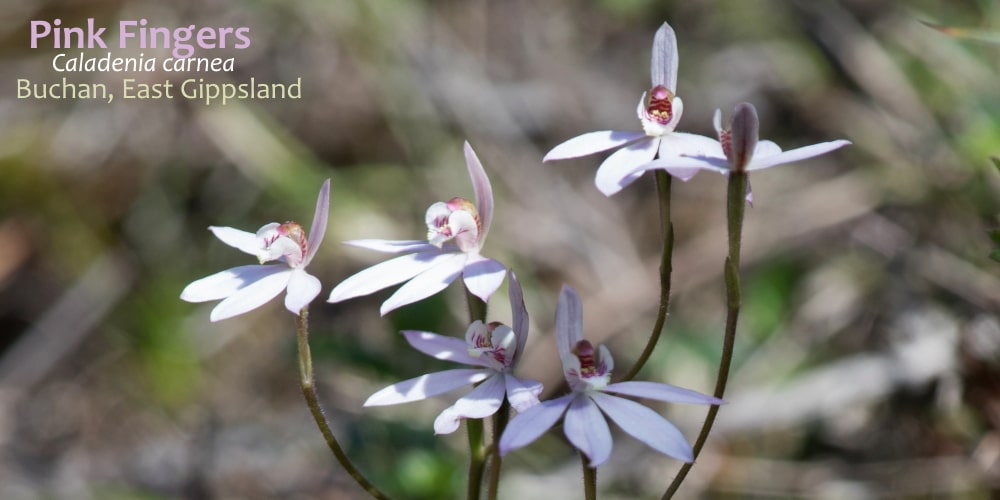
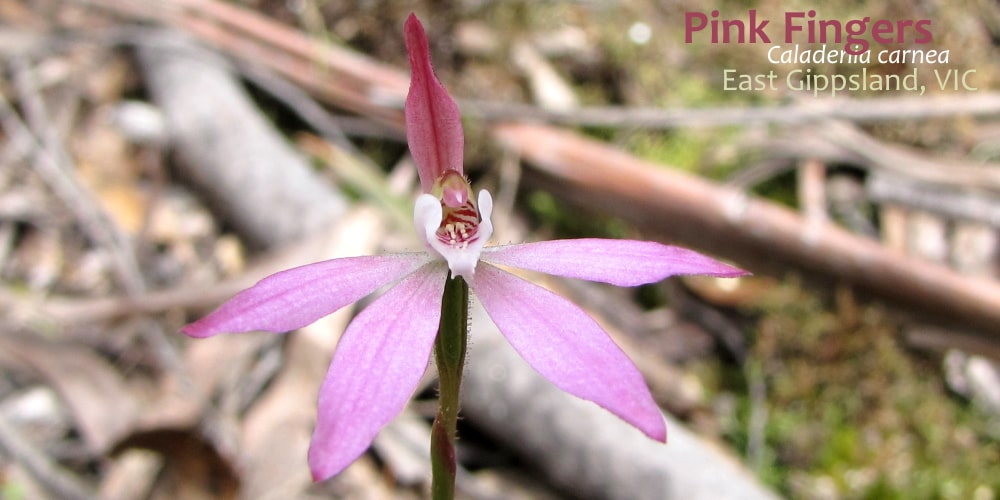
..
Flying Duck-orchid
Caleana major
Widespread in East Gippsland lowlands, but these orchids can be hard to see due to their colouring.
Flowering: Sept-Dec
Pollinators: Sawflies: Lophyrotoma interrupta, L. nigripes, L. ramosa, L. zonalis
Distinctive features: Everything about this orchid is distinctive. Only Small Duck-orchid is similar.
Similar species: Small Duck-orchid Paracaleana minor is more green, doesn’t have the prominent duck-shaped head.
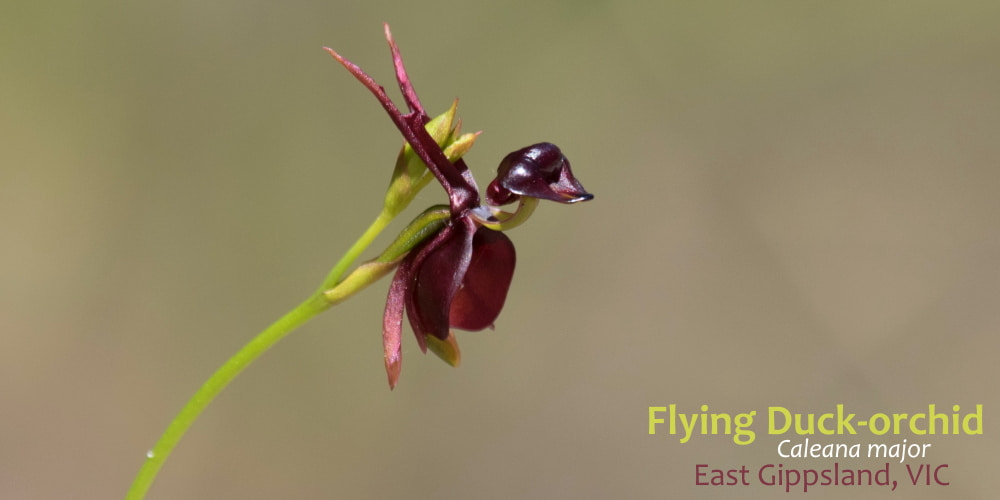
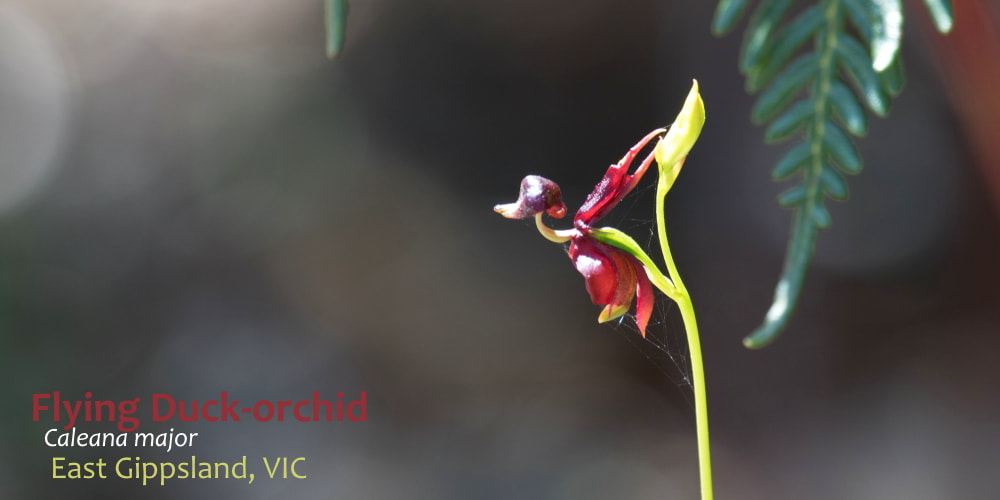
..
Streaked Rock-orchid
Dendrobium striolata
Only seen in a few rocky places, mostly in the far east. Can form large colonies on rocks. It is a lithophyte: it doesn’t grow in soil, but on rock faces.
Flowering: Sept-Nov
Pollinators: I can’t find.
Distinctive features: The leaves are perennial (long-lived) and form large mats in some places. The flower is very distinctive, green-orange with a white labellum.
Similar species: none really
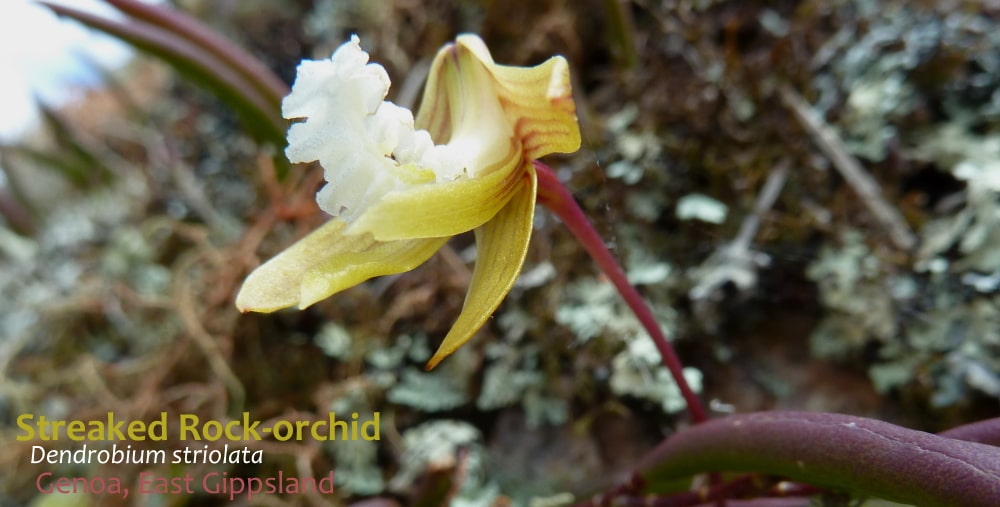

..
Rosy Hyacinth Orchid
Dipodium roseum
Widespread and common in open forests woodlands and heathlands. This is a large orchid – up to 1m high – and is a leafless saprophyte: it feeds on decaying organic matter, through a relationship with soil fungi.
Flowering: Dec-Feb
Pollinators: Apidae, Exoneura bicolor, Colletidae, Hylaeus quadriceps, Halictidae, Lasioglossum lanarium, Lipotriches flavoviridis, Megachilidae, Megachile ferox, M. obtusa.
Distinctive features: tips of flower perianth (petals & sepals) curved backwards.
Similar species: Purple Hyacinth Orchid Dipodium punctata – perianth tips curved forwards.


..
Wallflower Orchid
Diuris orientis
Widespread, coast and lowlands.
Flowering: Sept-Oct
Pollinators: Apidae (native bees) , Exoneura bicolor (reed bees), Colletidae (plasterer bees), Trichocolletes serotinus, T. venustus (native bees)
Distinctive features: Mostly yellow with diffuse red points, but not spotted like Tiger and Leopard Orchids.
Similar species: Tiger Orchid D. sulphurea & Leopard Orchid D pardina.
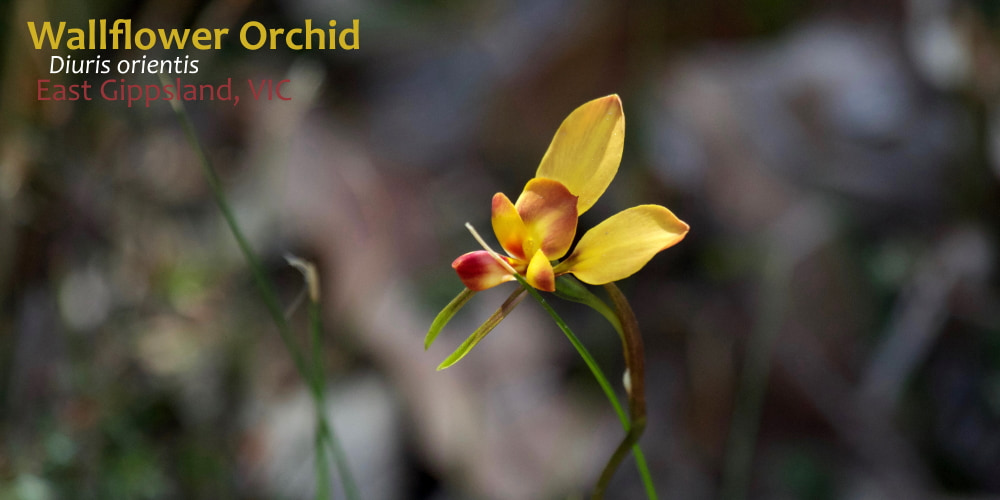
..
Purple Diuris
Diuris punctata
widespread, coastal.
Flowering: Oct-Nov
Pollinators: Halictidae (sweat bees): Lasioglossum lanarium, L. calophyllae, Lipotriches australica
Distinctive features: The only plain purple Diuris in the area.
Similar species: Blotched Diuris D. sp aff dendrobioides (Bairnsdale) is more blotched with purple on a pale background
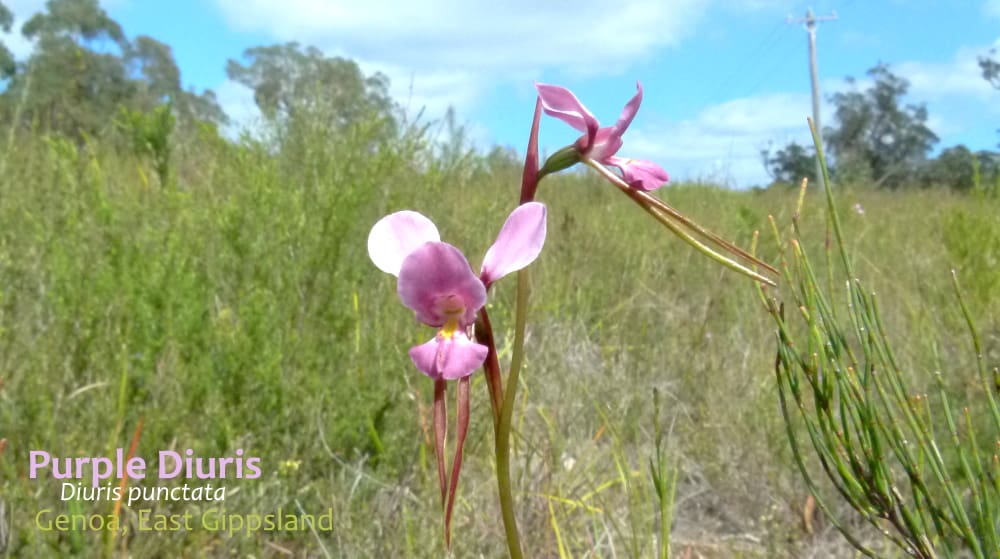
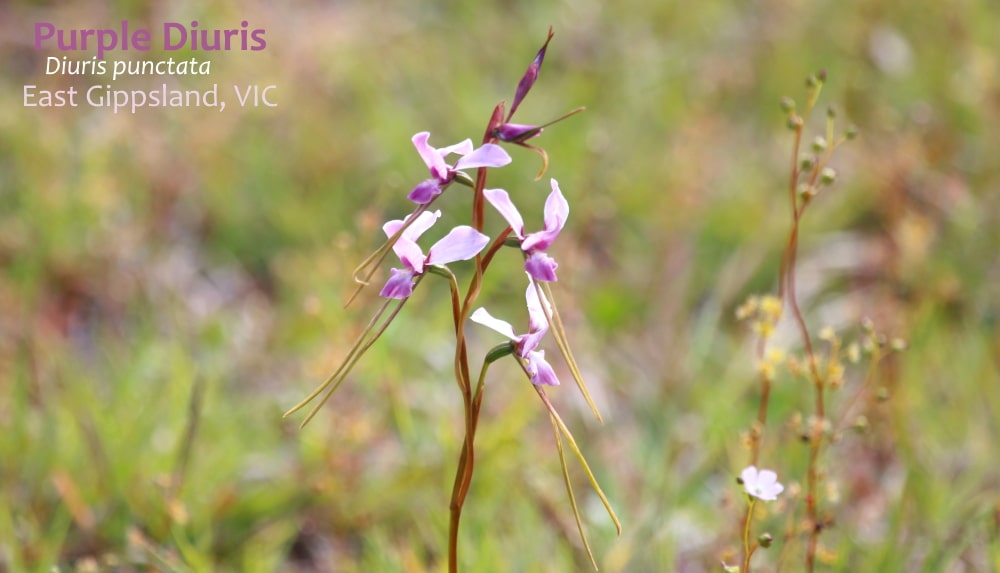
..
Tiger Orchid
Diuris sulphurea
widespread
Flowering: Oct-Dec
Pollinators: Apidae (native bees), Exoneura bicolor (reed bees), Amegilla asserta (blue-banded bees), Halictidae (sweat bees): Lipotriches flavoviridis
Distinctive features: A large orange-yellow diuris to 60cm tall, with fairly regular brown blotches on labellum, at base of dorsal sepal, and at bases of petals.
Similar species: Leopard Orchid D pardina has more spots on the edges of the petals and sepals, Wallflower D orientis isn’t blotched or spotted, but has more diffuse brown shading.
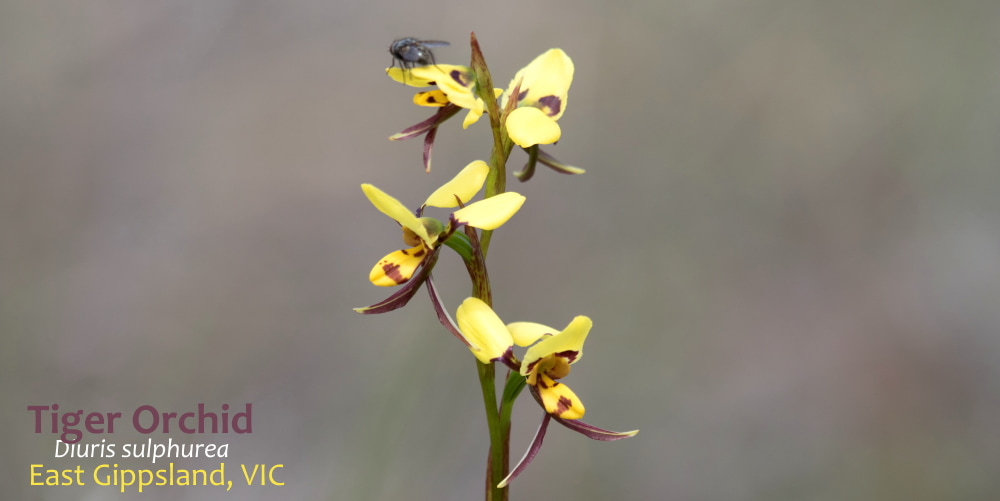
..
Cinnamon Bells
Gastrodia sesamoides
Uncommon, but widespread in open forest. A leafless saprophyte. Flowers are sweetly-scented.
Flowering: Oct-Jan. We saw this one in December 2017
Pollinators: Apidae (native bees), Exoneura bicolor (reed bees), Halictidae (sweat bees): Lipotriches flavoviridis & Lasioglossum sp
Distinctive features: Quite large, with brown flowers with white centres.
Similar species: Tall Cinnamon Bells Gastrodia procera is bigger (to 1m high) with many flowers usually tightly packed together. This one is usually in higher mountain country.


..
Waxlip Orchid
Glossodia major
Widespread and common in lower altitudes.
Flowering: Sept-Dec
Pollinators: Apidae (native bees), Exoneura bicolor (reed bees), Halictidae (sweat bees): Homalictus urbanus, Lasioglossum calophyllae, L. gynochilum, L. hemichalceum, L. hilcatum, L. lanarium
Distinctive features: A fairly big, showy purple orchid
Similar species: Small Waxlip Glossodia minor is smaller, has a mostly purple labellum (waxlip) and a big, colourful column. Waxlips can also be confused with Caladenias, but is usually bigger, and dorsal sepal doesn’t stick upright or hook over.

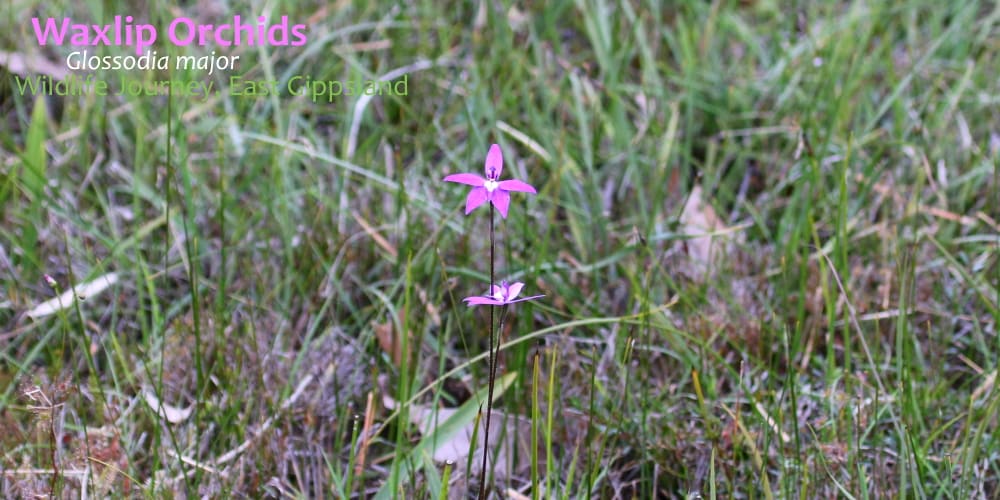
..
Trim Greenhood
Pterostylis concinna
Widespread across coastal plains
Flowering: May-Sept
Pollinators: Mycetophilidae (fungus gnats): Phthinia sp 1., Sciaridae (dark-winged fungus gnats)
Distinctive features: forms large colonies, sometimes hundreds of plants. Green flower with brown points at edges and tip. Labellum has a V notch at tip.
Similar species: Coastal Greenhood P alveata is greener, labellum doesn’t have V notch.
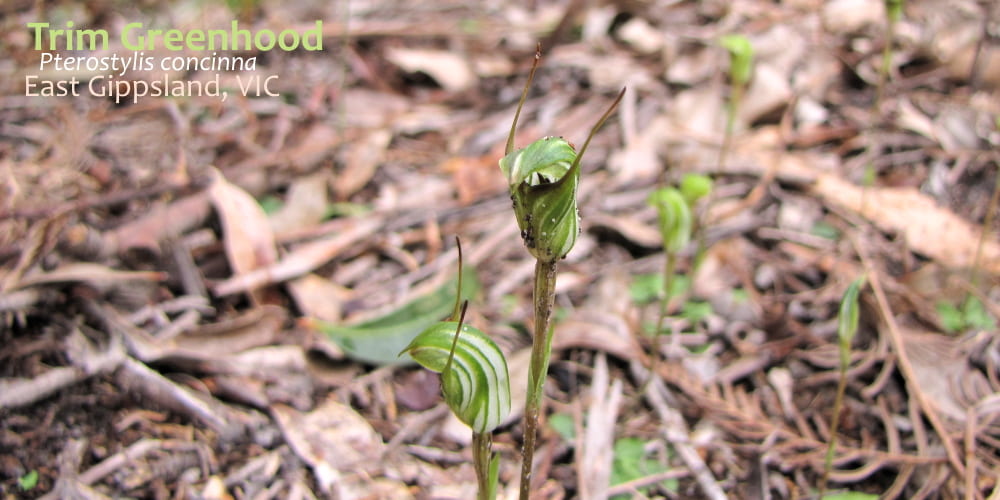
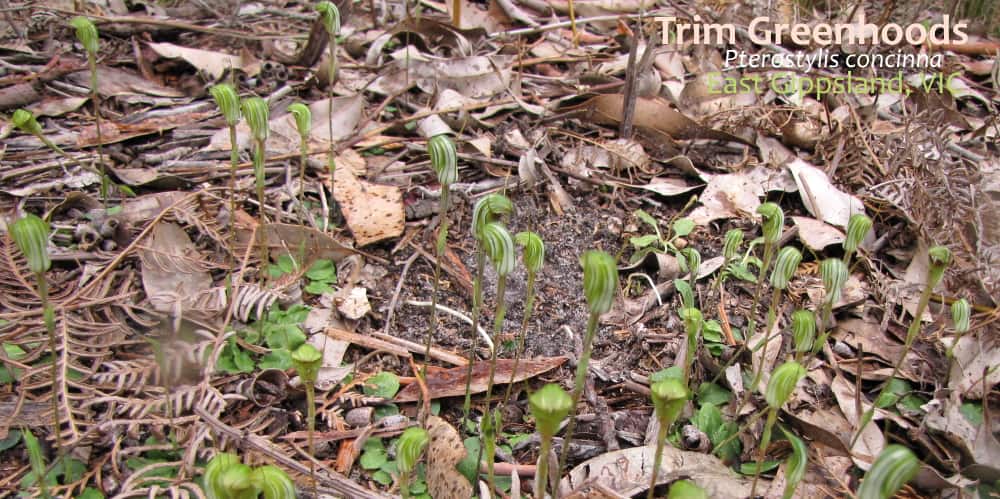
..
Maroonhood
Pterostylis pedunculata
Widespread, fern gullies
Flowering: July-Oct
Pollinators: Leia sp 1 (fungus gnats)
Distinctive features: short tip to dorsal sepal, lovely reddish colour
Similar species: Scarlet Greenhood P. coccina has a long tip to dorsal sepal and galea is more brown, Antelope Greenhood P. laxa has very long lateral sepals and a long tip to dorsal sepal, Striped Greenhood P. striata has lateral sepals curved inwards.

..
Gunn’s Tree Orchid / Butterfly Orchid
Sarcochilus australis
Sheltered gullies and rainforests. An evergreen epiphyte with usually only a few leaves. Easily overlooked.
Flowering: Oct-Dec
Pollinators: native bees
Distinctive features: A very distinctive tree orchid, small white flowers with purple spots.
Similar species: Orange-blossom Orchid, but very rare in East Gippsland.
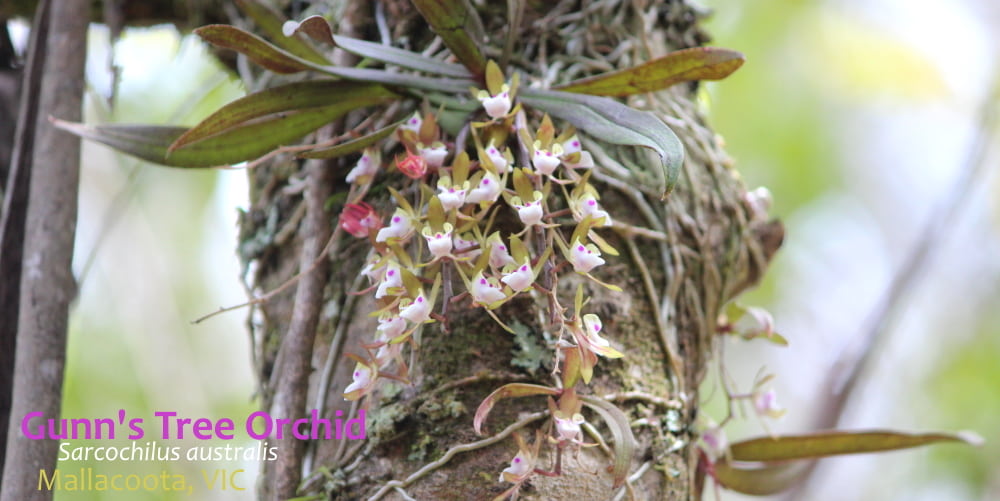
..
Forest Sun-orchid
Thelymitra arenaria
Widespread from coast to mountains. Seen on Raymond Island.
Flowering: Oct-Dec
Pollinators: Colletidae (plasterer bees): Hylaeus quadriceps.
Distinctive features: A lovely blue-purple sun orchid.
Similar species: there are many blue-purple sun-orchids. Close attention to shape and colour of column is most helpful. Highland Sun-orchid T alpina is very similar but grows in alpine regions.
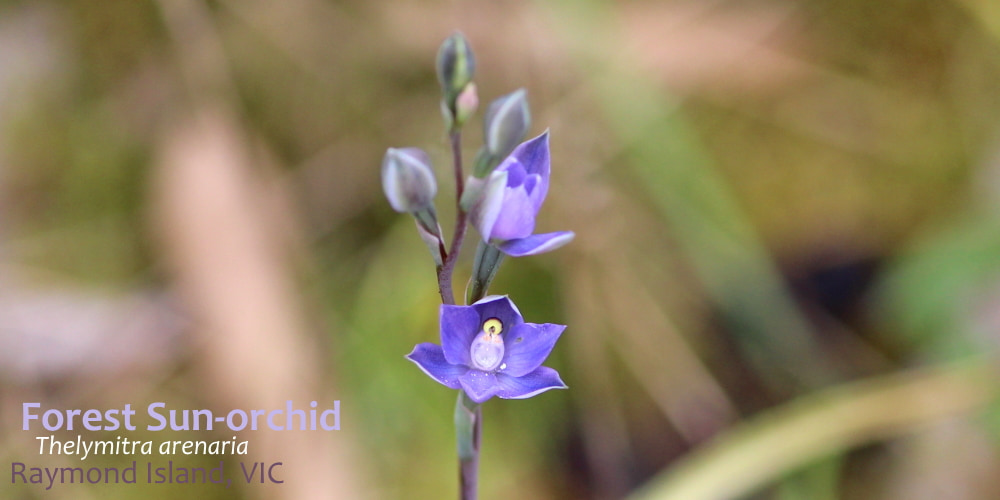
..
Pink Sun-orchid
Thelymitra carnea
Widespread in east
Flowering: Sept-Oct
Pollinators: can’t find. Possibly some self-pollinated.
Distinctive features: One of few sun-orchids in region that are pink. Column lobe is yellow and without white hair tufts.
Similar species: Slender Sun-orchid can be pink, but column lobe has white hair tufts. Salmon Sun-orchid is also pink but has bigger column.


Rush-leaf Sun-orchid/Spotted Sun-orchid
Thelymitra juncifolia or ixioides
I’m not 100% sure of this identification – I first had it as T ixioides, then changed to T juncifolia. Need expert opinion.
Flowering: Oct-Nov
Pollinators: T. ixioides: Lasioglossum calophyllae, L. lanarium (sweat bees)
Distinctive features: T juncifolia has just a few spots on the dorsal sepal and petals. T ixioides can be very spotted, or plain.
Similar species: Spotted Sun-orchid T. ixioides which is usually spottier across all the petals and sepals, but very variable. Close detail of column is required.
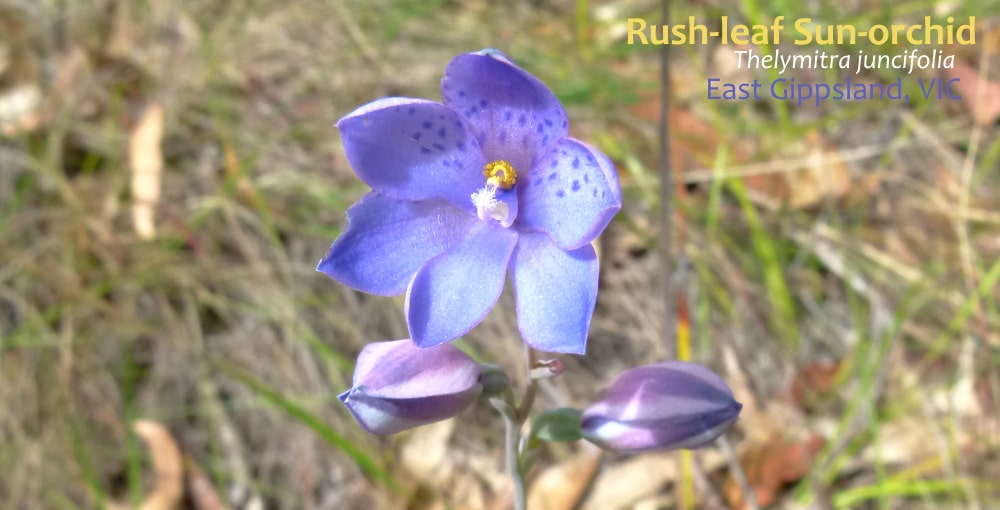
…
About orchid flower parts:
Orchids have fascinating flowers that are highly variable in every way. One thing they all have in common is that they are bilaterally symmetrical: the left side is the same as the right side. They all have six parts to the flower (called the perianth).
Sepals:
There are three sepals. Sometimes they all look exactly like petals – see sun-orchids. Others have a prominent dorsal (back) sepal that sticks straight up – see caladenias . In some it becomes a hood over the whole flower – see Helmet-orchids (not in this post); or fuses with the other sepals/petals to form a bell – see greenhoods.
Sometimes the flower is reversed so the dorsal sepal is pointing downwards – see Streaked Rock-orchid.
Petals:
There are three petals. Usually the middle one looks different to the others, and is called a labellum. In sun-orchids the labellum is the same as all the other petals and sepals. The labellum can be crazy shapes: it can look like a duck’s head – see Flying Duck-orchid, or an insect – see Caladenia Spider Orchids and Chiloglottis (not in this post); or even have a beard – see Calochilus (not in this post).
There is another part of the flower called the column. It houses the stigma (female) and anthers (male) parts that reproduce sexually. It is usually in the centre of the flower, but is sometimes hidden – eg in greenhoods.
Knowing the structure of the orchid flower, and deducing what is what on a new orchid makes them even more fun!
Here is a few of the orchid flowers, labelled for flower structure.

Flower parts of Caladenia orchid

Flower parts of Caleana orchid

Flower parts of Dendrobium orchid

Flower parts of Dipodium orchid

Flower parts of Diuris orchid

Flower parts of Gastrodia orchid

Flower parts of Glossodia orchid

Flower parts of Pterostylis orchid

Flower parts of Sarcochilus orchid

Flower parts of Thelymitra orchid
Orchid experts: Please comment if I’ve mis-identified any of the orchids. Thankyou.
..
NOTES & REFERENCES:
Most of the identification and notes have been sourced from the wonderful book “Orchids of East Gippsland: A Field Guide” published by the Bairnsdale & District Field Naturalists Club Inc. Buy this book: https://www.publish.csiro.au/book/7427/
Fabulous information on Victoria native orchids and their pollinators here: https://www.researchgate.net/publication/323303999_List_of_Orchids_and_their_Pollinating_Agents_of_Victoria_List_of_Orchids_and_their_Pollinating_Agents_of_Victoria

